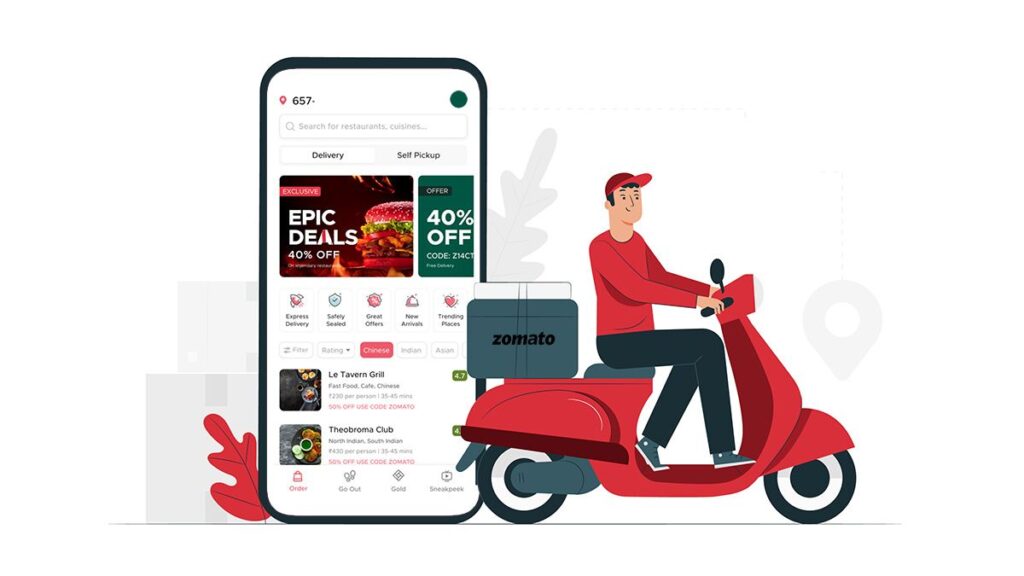Table of Contents
1. How does Zomato Make Money via Commission on Food Delivery Orders
The cornerstone of Zomato’s revenue model is the commission it charges partner restaurants. These commissions typically range between 15% to 25% of the total order value. As part of Zomato’s business model, this revenue stream benefits both the platform and the restaurants, which gain access to Zomato’s extensive customer base.

2. How does Zomato Make Money via Delivery Charges
Zomato earns money through delivery fees charged to customers. These fees vary based on order size, delivery distance, and peak times. This revenue stream is critical, covering logistics costs while adding to Zomato’s profitability. The company’s quarterly results consistently show the significance of delivery charges in its overall revenue.
3. Advertising Revenue
Advertising is a major contributor to how Zomato makes money. Restaurants can pay for premium placements, banner ads, and sponsored listings to improve their visibility. With its large user base, Zomato positions itself as a powerful platform for targeted advertising, enhancing the appeal of its business model.
4. Subscription Services
Zomato Pro, a subscription-based program, is a key component of the Zomato revenue model. Subscribers pay a fee to access discounts and exclusive deals. The subscription offers significant value to users while creating recurring revenue for Zomato.
5. Hyperpure Initiative
As part of the Zomato business model, Hyperpure supplies fresh ingredients to partner restaurants. This service helps Zomato earn money by acting as an intermediary between suppliers and restaurants, while also ensuring quality standards. Hyperpure aligns with Zomato’s quarterly results, which often highlight this growing segment.
6. Data Analytics and Consultancy
Zomato’s vast repository of customer data allows it to provide insights and consultancy services to restaurants. This service aligns with the company’s goal of leveraging technology to drive revenue and strengthen its competitive position.
7. How does Zomato make money via Ancillary Ventures: Event Ticketing and More
Zomato has expanded its business model by venturing into event ticketing and related services. These additional revenue streams illustrate how Zomato makes money beyond its core operations.
Zomato’s Growth and Market Position
SWOT Analysis of Zomato
- Strengths: A diversified revenue model, strong market presence, and innovative services.
- Weaknesses: High operational costs and dependency on the food delivery sector.
- Opportunities: Expansion into international markets and growing its Hyperpure and subscription services.
- Threats: Competitors like Swiggy and evolving regulatory challenges.
Zomato Share Holding Pattern
The latest shareholding pattern reveals:
- Foreign Institutional Investors (FIIs): 55.32%
- Domestic Institutional Investors (DIIs): 14.08%
- Public and Others: 30.60%
This balanced shareholding pattern reflects Zomato’s strong investor confidence.
Zomato Share Price Targets for 2023 and 2030
Zomato’s financial success and innovative business model have piqued investor interest:
- Zomato Share Price Target 2023: Analysts estimate a target of ₹80 to ₹90, based on quarterly results and operational growth.
- Zomato Share Price Target 2030: Long-term projections suggest ₹190 to ₹230, reflecting Zomato’s robust potential.
Conclusion
So, How does Zomato make money? It is through a blend of commissions, delivery fees, advertising, subscriptions, and innovative ventures like Hyperpure. Its revenue model is a testament to its adaptability and foresight. With its comprehensive business model, strong shareholding pattern, and consistent quarterly results, Zomato continues to stand out among Indian Startups in the highly competitive food tech industry.


















